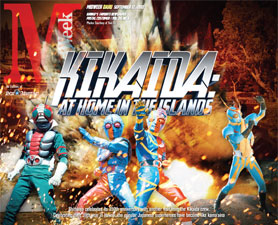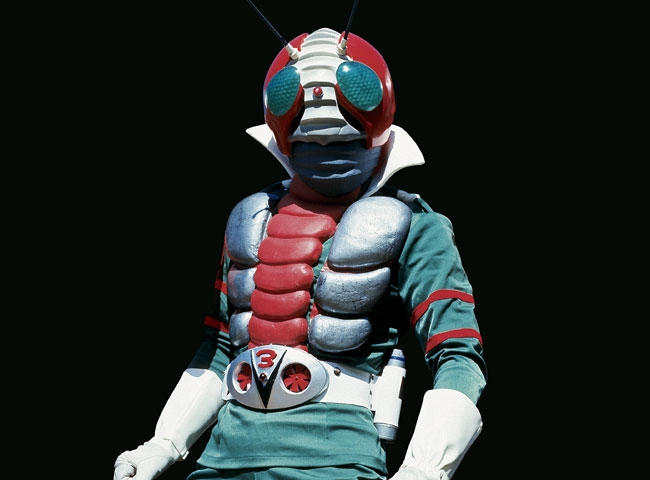Kikaida: At Home in the Islands
GENERATIONS OF LOCAL FOLKS SHARE THEIR LOVE OF KIKAIDA AND PALS, AND IN TURN THE ACTORS WHO PLAY THE SUPERHEROES LOVE HAWAII’S PEOPLE
Most things that try to migrate to Hawaii are quickly shown the door – whether it is the Superferry, van cams or a gambling bill, we have very little patience with outside influences.
But occasionally one slips through on us and we take it inexplicably to our breast. We welcome it in, make it our own and to paraphrase the infamous RA axiom, you can take it from us when you pry it from our cold, dead hands.
Examples are all around you. Longs Drugs, now as extinct as the dodo on the Mainland, continues to use its signature cursive logo and name here in Hawaii because we would not accept its new name, CVS.
Spam, an anachronism from a time when it was impossible to keep meat fresh during shipping, thrives here as if its flower only blooms out of the fresh pahoehoe on the slopes of Kilauea.
Even women’s volleyball, a peripheral sport anywhere else in the country, reigns so supreme here that we cut into Major League Baseball playoff broadcasts to bring coverage of the Wahine versus the Lady Vandals.
So it is a moment of great local celebration this Sunday (Sept. 16) as two of our favorite imports celebrate their birthdays together with Shirokiya, marking its 350th, and every local kid’s favorite kid show from the ’70s, Kikaida, celebrating its 40th.
The event is being held at Shirokiya from 2 to 3:30 p.m. and will feature the original Jiro, Ban Daisuke from Kikaida, and Kazami Shiro and Miyauchi Hiroshi from Kamen Rider V3 as they will pose for pictures with and sign autographs for fans.
Daisuke has been here many times. His first visit at Pearlridge in 1974 nearly caused a riot with a throng of 10,000 residents flooding the mall wanting to meet their robot-battling hero, but it still astonishes him – the ardor of local fans.
“In Hawaii, it became a cultural phenomenon, and never in my wildest dreams did I think it would be such a big hit,” says Daisuke. “To this day, it amazes me that a new generation of kids are watching the DVD.”
If you did not live in the Islands in the early ’70s, it is hard to picture how big a sensation Kikaida was to that generation. When it debuted in Hawaii in February 1974 it took a 25 percent share of the market while airing on the unassuming all Japanese station KIKU. It was taking down network TV shows like Mission Impossible (yes, it used to be a TV series) with bad guys in rubber suits who thwarted our hero – no joke – with a magical flute.
But to this day, the series still holds a spot in locals’ hearts, passed down to the next generation like Grandma’s china, if only Tutu’s tableware could kick robot okole.
“It means a lot to me,” says Daisuke. “I’m gratified that people still remember, and many kids from the mid-’70s have gone on to pursue careers in filmmaking and TV production. Hawaii is a special place, and its citizens have warmth in their hearts. Three generations of Kikaida fans attend our events, and Hawaii people openly express their love for Kikaida.”
While the show has not been broadcast for 30 years, the release of the DVDs has allowed the lovefest to continue into the new generation in a way that these stars do not experience even in their home country.
“I have done thousands of appearances as Kazami Shiro in Japan, but it never fails to amaze me that in Hawaii, grandparents and parents attend our events with kids in tow,” says Hiroshi. “I have never seen this happen in Japan. Kamen Rider has been around now for 40 years, and events are centered around adults in their 40s and 50s. Only in Hawaii do you see several generations coming to our events together.”
The keiki of the Islands actually had an influence on Hiroshi, helping him create his signature move in the next series he starred in, Kaiketsu Zubatto.
“I loved the shy expressions of kids when I was here 38 years ago, with fingers to their mouths and giggling,” remembers Hiroshi. “I loved it so much that I ended up using that pose in Kaiketsu Zubatto.”
Expect to see that move and more of your favorites this Sunday, but perhaps of even larger note on a historical scale is the anniversary of the store in which this meet-and-greet will be held.
If you do not follow the comings and goings of the mercantile industry in the Far East, it probably passed unnoticed to you that the Shirokiya chain shut down all operations in Japan last year. It was originally founded in 1662 by Hikotaro Omura as a dry goods store in Edo, now known as Tokyo. It is the oldest still-active store from Japan, but the Ala Moana store was slated for the chopping block as well, until the people of Hawaii stepped in.
A petition was circulated asking to save the store and more than 30,000 local residents put their names to the paper, most noticeably U.S. Sen. Daniel Inouye. The petition was forwarded to the Tokyu Group, which was so moved by this outpouring that it sold the final store in its chain for exactly $1 to the top seven executives in the Honolulu store.
This proved to be a $23 million loss for the company, but a value could not be put on what it meant to locals to keep their favorite Japanese department store open for business.
In order to reward locals for their dedication, the store has been receiving some major renovations.
The first step opened last year with YATAIMURA replacing the housewares section on the upper level. It was envisioned as a traditional Japanese bazaar offering 21 “yatai” highlighting the best food from Japan. Instead of cramped shelves of goods, the space has been opened up to accommodate 160 seats where diners can choose from items including soba noodles, sushi and assorted oden.
“The food court is entertainment,” says Toshiyuki Okumura, president of Shirokiya. “We like to give a lot of foods, but not only that, we want people to have fun, that is why we put in that trellis whose flowers change with the season. We want people to come, eat, relax and have fun. We could have merchandise there, but we want people to come and enjoy good, Japanese food.”
Perhaps its most popular local addition has been its happy hour that features $1 beers to go with that wide selection of Japanese fare. While your local department store may not seem like the coolest place to imbibe, the prices sure have helped boost its pop ularity.
Another addition that even those who never venture inside Shirokiya will notice is the glassed-in radio studio for the beloved Japanese radio station, KZOO 1210 AM.
It is on the mall level facing Macy’s and features a garden, a waiting area for on-air guests and the studio itself. During regular business hours customers will be able to watch their favorite on-air personalities broadcasting their shows.
“The idea with the satellite studio is mainly because the radio station has been here for many years, too, and for local Japanese people they wake up to KZOO and go to sleep listening to it, so we thought we could be partners,” says Okumura. “It would be good for Hawaii people to come hang out and see their radio hosts. ‘Let’s go to Shirokiya to have fun!'”
And that is the plan for this weekend, some fun with some old friends, friends from a simpler time when battling robots with names like Bitter-Orange Snail and Grey Rhino King could strike fear into a young person’s heart.







